NAIDOC Celebration Week Project Plan
VerifiedAdded on 2024/05/27
|16
|4191
|70
AI Summary
This project plan outlines the comprehensive strategy for managing the NAIDOC Celebration Week at CQU University. The celebration aims to foster understanding and appreciation of Aboriginal and Torres Strait Islander culture, history, and protocols. The project involves various stakeholders, including students, staff members, the SET team, Aboriginal and Torres Strait Islander communities, CQU University, material suppliers, and the management team. The plan details the project scope, work breakdown structure, schedule, cost baseline, risk assessment, tolerances, and lessons learned. It emphasizes the importance of stakeholder engagement, requirement gathering, and effective communication to ensure a successful and impactful celebration.
Contribute Materials
Your contribution can guide someone’s learning journey. Share your
documents today.
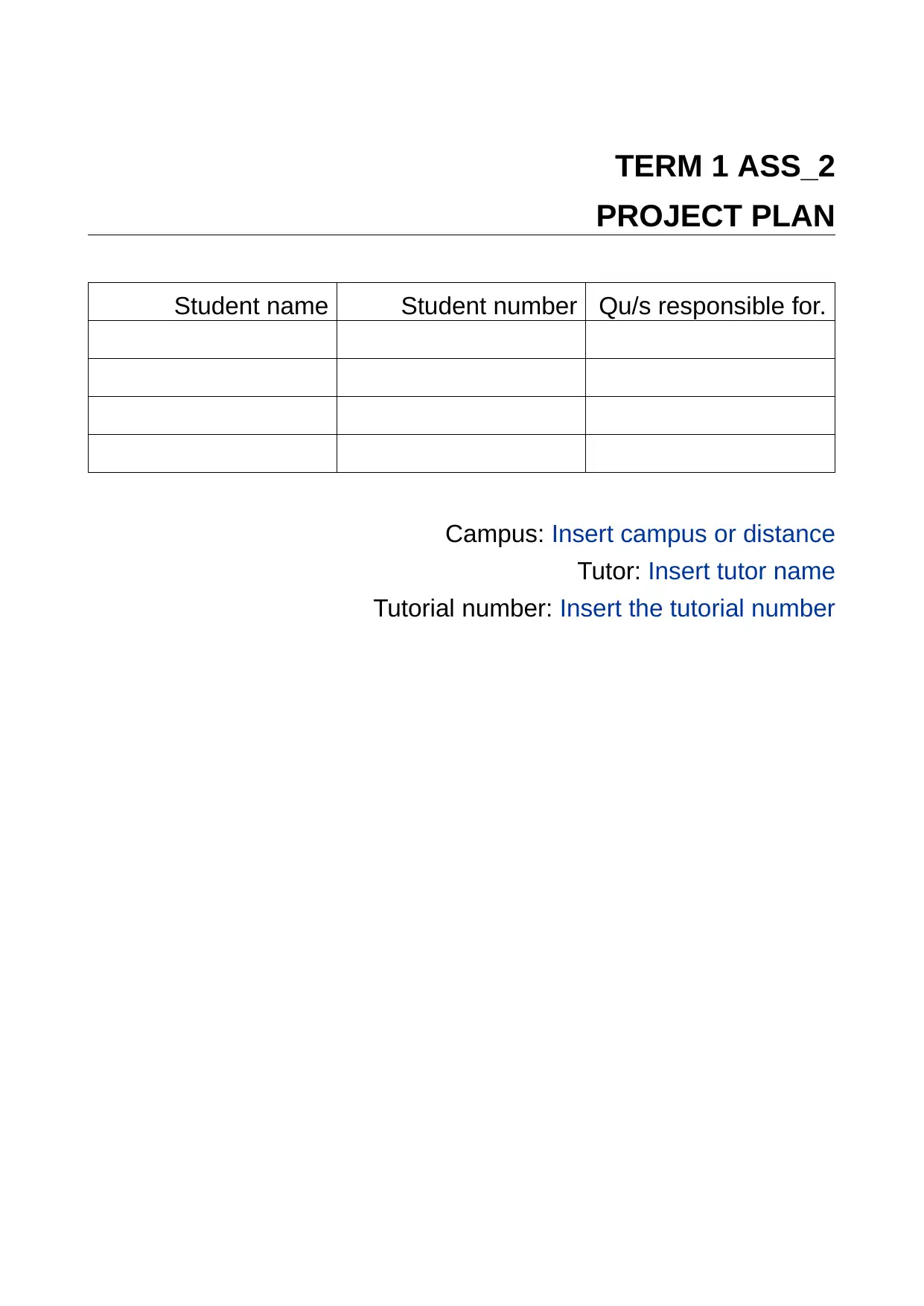
TERM 1 ASS_2
PROJECT PLAN
Student name Student number Qu/s responsible for.
Campus: Insert campus or distance
Tutor: Insert tutor name
Tutorial number: Insert the tutorial number
PROJECT PLAN
Student name Student number Qu/s responsible for.
Campus: Insert campus or distance
Tutor: Insert tutor name
Tutorial number: Insert the tutorial number
Secure Best Marks with AI Grader
Need help grading? Try our AI Grader for instant feedback on your assignments.
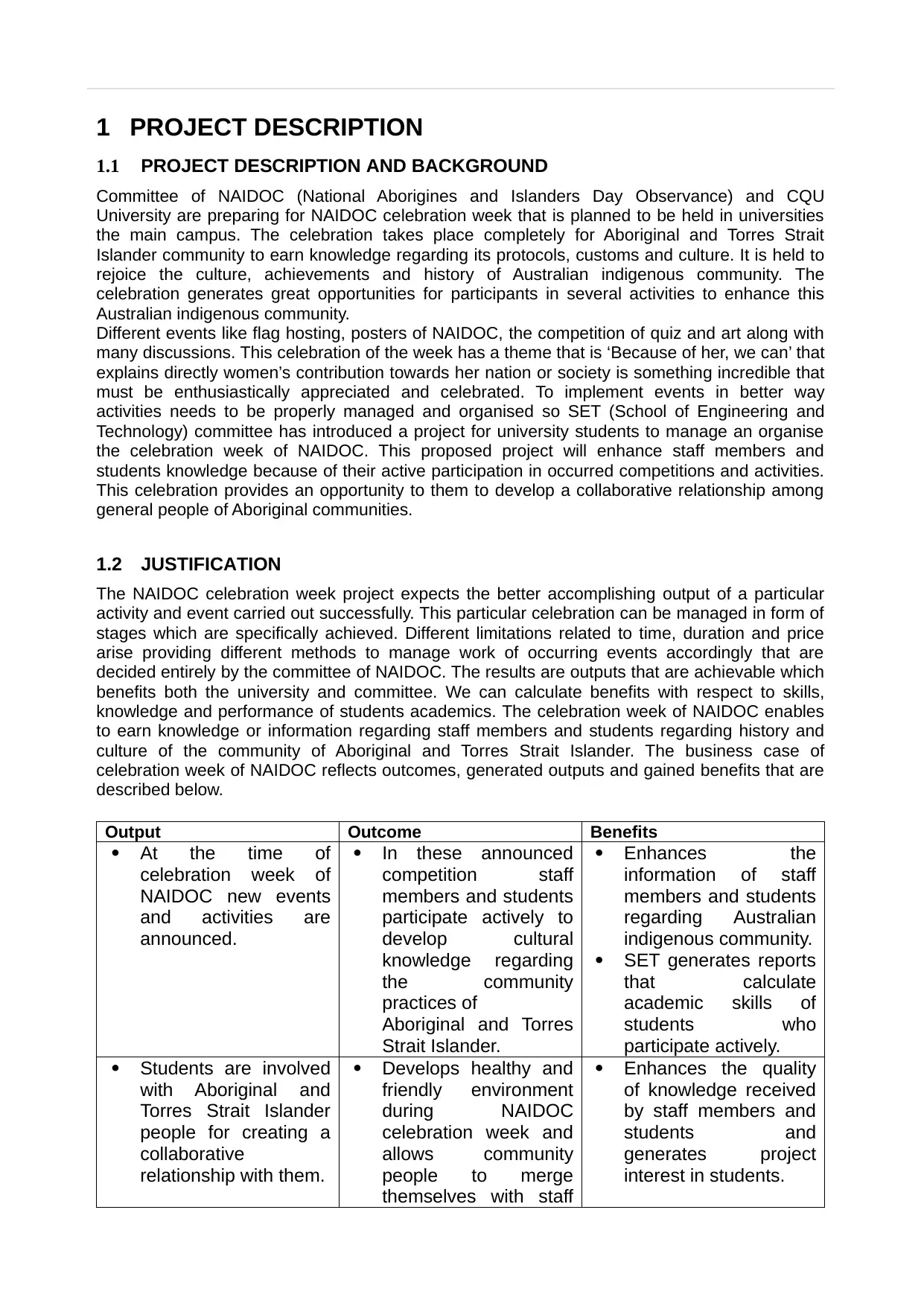
1 PROJECT DESCRIPTION
1.1 PROJECT DESCRIPTION AND BACKGROUND
Committee of NAIDOC (National Aborigines and Islanders Day Observance) and CQU
University are preparing for NAIDOC celebration week that is planned to be held in universities
the main campus. The celebration takes place completely for Aboriginal and Torres Strait
Islander community to earn knowledge regarding its protocols, customs and culture. It is held to
rejoice the culture, achievements and history of Australian indigenous community. The
celebration generates great opportunities for participants in several activities to enhance this
Australian indigenous community.
Different events like flag hosting, posters of NAIDOC, the competition of quiz and art along with
many discussions. This celebration of the week has a theme that is ‘Because of her, we can’ that
explains directly women’s contribution towards her nation or society is something incredible that
must be enthusiastically appreciated and celebrated. To implement events in better way
activities needs to be properly managed and organised so SET (School of Engineering and
Technology) committee has introduced a project for university students to manage an organise
the celebration week of NAIDOC. This proposed project will enhance staff members and
students knowledge because of their active participation in occurred competitions and activities.
This celebration provides an opportunity to them to develop a collaborative relationship among
general people of Aboriginal communities.
1.2 JUSTIFICATION
The NAIDOC celebration week project expects the better accomplishing output of a particular
activity and event carried out successfully. This particular celebration can be managed in form of
stages which are specifically achieved. Different limitations related to time, duration and price
arise providing different methods to manage work of occurring events accordingly that are
decided entirely by the committee of NAIDOC. The results are outputs that are achievable which
benefits both the university and committee. We can calculate benefits with respect to skills,
knowledge and performance of students academics. The celebration week of NAIDOC enables
to earn knowledge or information regarding staff members and students regarding history and
culture of the community of Aboriginal and Torres Strait Islander. The business case of
celebration week of NAIDOC reflects outcomes, generated outputs and gained benefits that are
described below.
Output Outcome Benefits
At the time of
celebration week of
NAIDOC new events
and activities are
announced.
In these announced
competition staff
members and students
participate actively to
develop cultural
knowledge regarding
the community
practices of
Aboriginal and Torres
Strait Islander.
Enhances the
information of staff
members and students
regarding Australian
indigenous community.
SET generates reports
that calculate
academic skills of
students who
participate actively.
Students are involved
with Aboriginal and
Torres Strait Islander
people for creating a
collaborative
relationship with them.
Develops healthy and
friendly environment
during NAIDOC
celebration week and
allows community
people to merge
themselves with staff
Enhances the quality
of knowledge received
by staff members and
students and
generates project
interest in students.
1.1 PROJECT DESCRIPTION AND BACKGROUND
Committee of NAIDOC (National Aborigines and Islanders Day Observance) and CQU
University are preparing for NAIDOC celebration week that is planned to be held in universities
the main campus. The celebration takes place completely for Aboriginal and Torres Strait
Islander community to earn knowledge regarding its protocols, customs and culture. It is held to
rejoice the culture, achievements and history of Australian indigenous community. The
celebration generates great opportunities for participants in several activities to enhance this
Australian indigenous community.
Different events like flag hosting, posters of NAIDOC, the competition of quiz and art along with
many discussions. This celebration of the week has a theme that is ‘Because of her, we can’ that
explains directly women’s contribution towards her nation or society is something incredible that
must be enthusiastically appreciated and celebrated. To implement events in better way
activities needs to be properly managed and organised so SET (School of Engineering and
Technology) committee has introduced a project for university students to manage an organise
the celebration week of NAIDOC. This proposed project will enhance staff members and
students knowledge because of their active participation in occurred competitions and activities.
This celebration provides an opportunity to them to develop a collaborative relationship among
general people of Aboriginal communities.
1.2 JUSTIFICATION
The NAIDOC celebration week project expects the better accomplishing output of a particular
activity and event carried out successfully. This particular celebration can be managed in form of
stages which are specifically achieved. Different limitations related to time, duration and price
arise providing different methods to manage work of occurring events accordingly that are
decided entirely by the committee of NAIDOC. The results are outputs that are achievable which
benefits both the university and committee. We can calculate benefits with respect to skills,
knowledge and performance of students academics. The celebration week of NAIDOC enables
to earn knowledge or information regarding staff members and students regarding history and
culture of the community of Aboriginal and Torres Strait Islander. The business case of
celebration week of NAIDOC reflects outcomes, generated outputs and gained benefits that are
described below.
Output Outcome Benefits
At the time of
celebration week of
NAIDOC new events
and activities are
announced.
In these announced
competition staff
members and students
participate actively to
develop cultural
knowledge regarding
the community
practices of
Aboriginal and Torres
Strait Islander.
Enhances the
information of staff
members and students
regarding Australian
indigenous community.
SET generates reports
that calculate
academic skills of
students who
participate actively.
Students are involved
with Aboriginal and
Torres Strait Islander
people for creating a
collaborative
relationship with them.
Develops healthy and
friendly environment
during NAIDOC
celebration week and
allows community
people to merge
themselves with staff
Enhances the quality
of knowledge received
by staff members and
students and
generates project
interest in students.
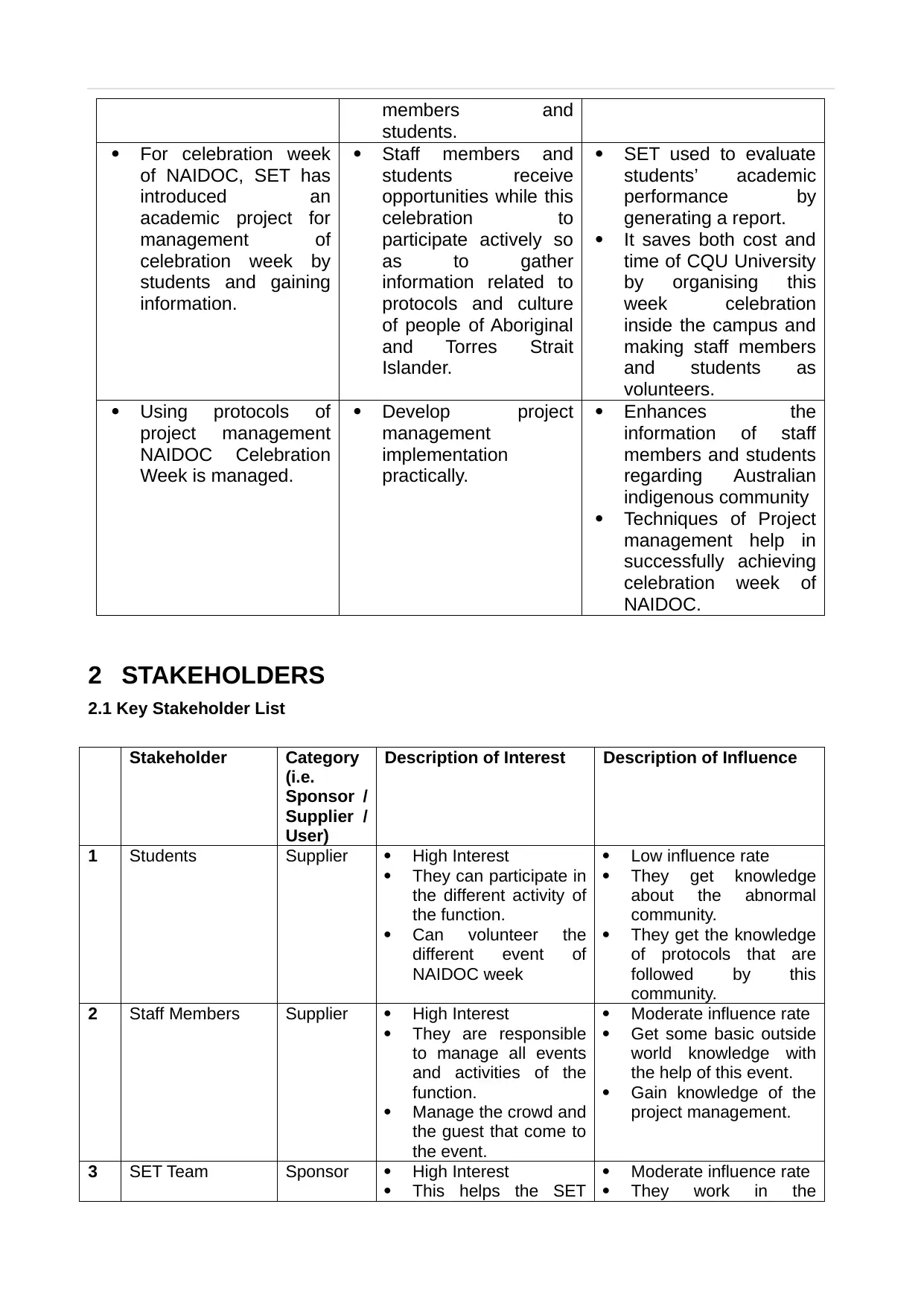
members and
students.
For celebration week
of NAIDOC, SET has
introduced an
academic project for
management of
celebration week by
students and gaining
information.
Staff members and
students receive
opportunities while this
celebration to
participate actively so
as to gather
information related to
protocols and culture
of people of Aboriginal
and Torres Strait
Islander.
SET used to evaluate
students’ academic
performance by
generating a report.
It saves both cost and
time of CQU University
by organising this
week celebration
inside the campus and
making staff members
and students as
volunteers.
Using protocols of
project management
NAIDOC Celebration
Week is managed.
Develop project
management
implementation
practically.
Enhances the
information of staff
members and students
regarding Australian
indigenous community
Techniques of Project
management help in
successfully achieving
celebration week of
NAIDOC.
2 STAKEHOLDERS
2.1 Key Stakeholder List
Stakeholder Category
(i.e.
Sponsor /
Supplier /
User)
Description of Interest Description of Influence
1 Students Supplier High Interest
They can participate in
the different activity of
the function.
Can volunteer the
different event of
NAIDOC week
Low influence rate
They get knowledge
about the abnormal
community.
They get the knowledge
of protocols that are
followed by this
community.
2 Staff Members Supplier High Interest
They are responsible
to manage all events
and activities of the
function.
Manage the crowd and
the guest that come to
the event.
Moderate influence rate
Get some basic outside
world knowledge with
the help of this event.
Gain knowledge of the
project management.
3 SET Team Sponsor High Interest
This helps the SET
Moderate influence rate
They work in the
students.
For celebration week
of NAIDOC, SET has
introduced an
academic project for
management of
celebration week by
students and gaining
information.
Staff members and
students receive
opportunities while this
celebration to
participate actively so
as to gather
information related to
protocols and culture
of people of Aboriginal
and Torres Strait
Islander.
SET used to evaluate
students’ academic
performance by
generating a report.
It saves both cost and
time of CQU University
by organising this
week celebration
inside the campus and
making staff members
and students as
volunteers.
Using protocols of
project management
NAIDOC Celebration
Week is managed.
Develop project
management
implementation
practically.
Enhances the
information of staff
members and students
regarding Australian
indigenous community
Techniques of Project
management help in
successfully achieving
celebration week of
NAIDOC.
2 STAKEHOLDERS
2.1 Key Stakeholder List
Stakeholder Category
(i.e.
Sponsor /
Supplier /
User)
Description of Interest Description of Influence
1 Students Supplier High Interest
They can participate in
the different activity of
the function.
Can volunteer the
different event of
NAIDOC week
Low influence rate
They get knowledge
about the abnormal
community.
They get the knowledge
of protocols that are
followed by this
community.
2 Staff Members Supplier High Interest
They are responsible
to manage all events
and activities of the
function.
Manage the crowd and
the guest that come to
the event.
Moderate influence rate
Get some basic outside
world knowledge with
the help of this event.
Gain knowledge of the
project management.
3 SET Team Sponsor High Interest
This helps the SET
Moderate influence rate
They work in the
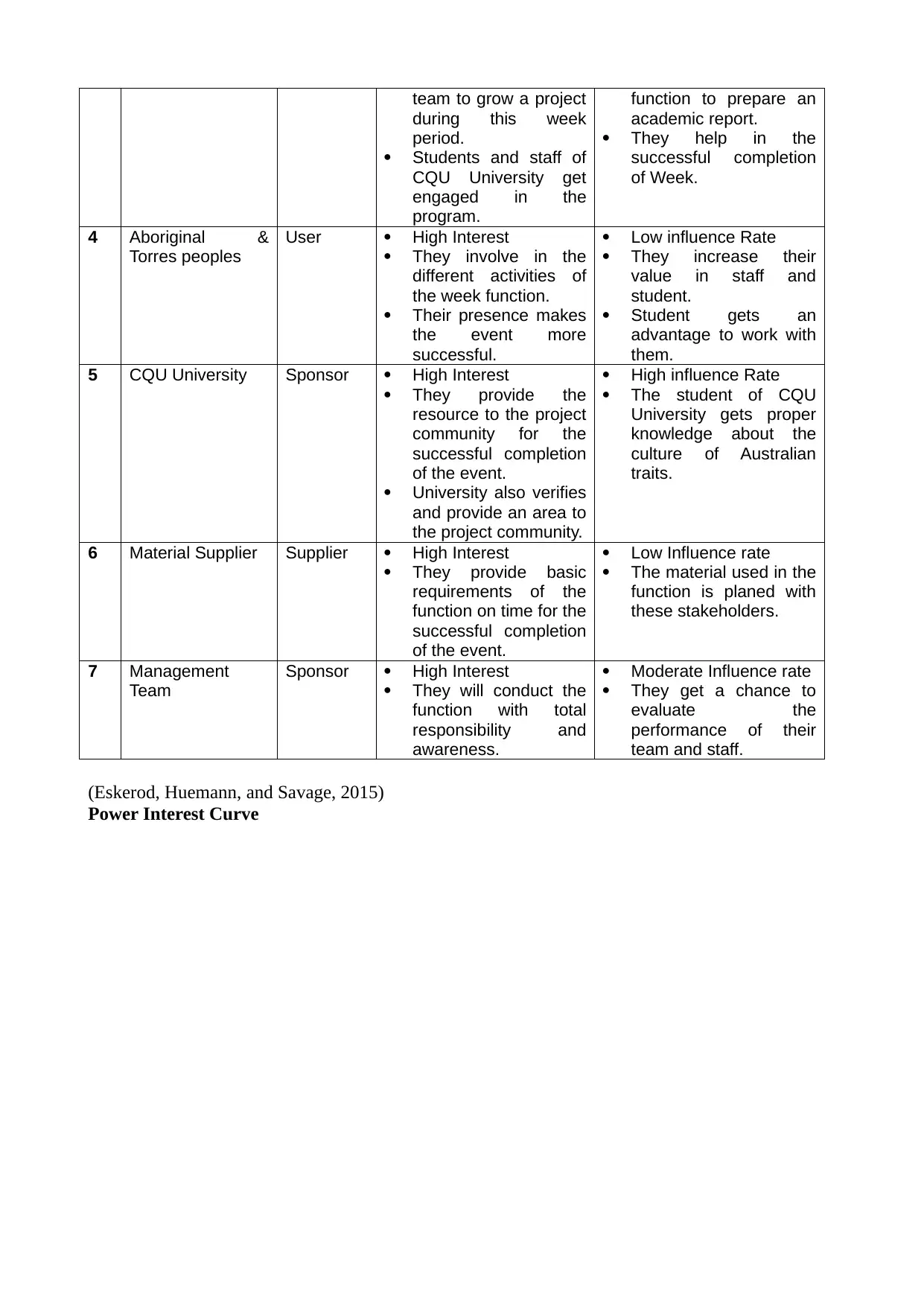
team to grow a project
during this week
period.
Students and staff of
CQU University get
engaged in the
program.
function to prepare an
academic report.
They help in the
successful completion
of Week.
4 Aboriginal &
Torres peoples
User High Interest
They involve in the
different activities of
the week function.
Their presence makes
the event more
successful.
Low influence Rate
They increase their
value in staff and
student.
Student gets an
advantage to work with
them.
5 CQU University Sponsor High Interest
They provide the
resource to the project
community for the
successful completion
of the event.
University also verifies
and provide an area to
the project community.
High influence Rate
The student of CQU
University gets proper
knowledge about the
culture of Australian
traits.
6 Material Supplier Supplier High Interest
They provide basic
requirements of the
function on time for the
successful completion
of the event.
Low Influence rate
The material used in the
function is planed with
these stakeholders.
7 Management
Team
Sponsor High Interest
They will conduct the
function with total
responsibility and
awareness.
Moderate Influence rate
They get a chance to
evaluate the
performance of their
team and staff.
(Eskerod, Huemann, and Savage, 2015)
Power Interest Curve
during this week
period.
Students and staff of
CQU University get
engaged in the
program.
function to prepare an
academic report.
They help in the
successful completion
of Week.
4 Aboriginal &
Torres peoples
User High Interest
They involve in the
different activities of
the week function.
Their presence makes
the event more
successful.
Low influence Rate
They increase their
value in staff and
student.
Student gets an
advantage to work with
them.
5 CQU University Sponsor High Interest
They provide the
resource to the project
community for the
successful completion
of the event.
University also verifies
and provide an area to
the project community.
High influence Rate
The student of CQU
University gets proper
knowledge about the
culture of Australian
traits.
6 Material Supplier Supplier High Interest
They provide basic
requirements of the
function on time for the
successful completion
of the event.
Low Influence rate
The material used in the
function is planed with
these stakeholders.
7 Management
Team
Sponsor High Interest
They will conduct the
function with total
responsibility and
awareness.
Moderate Influence rate
They get a chance to
evaluate the
performance of their
team and staff.
(Eskerod, Huemann, and Savage, 2015)
Power Interest Curve
Secure Best Marks with AI Grader
Need help grading? Try our AI Grader for instant feedback on your assignments.

2.2 Stakeholders Engagement Assessment Matrix
The terms that are related to the stakeholder engagement assessment matrix are as follows:
Unaware: These stake holders don’t have any information about the project.
Resistant: These stakeholders have some knowledge but they don’t want to engage in the
project.
Neutral: They are the moderate type of stakeholder that have interest and also have
engagement.
Supportive: These stakeholders are responsible for the successful completion of the
project.
Leading: These stakeholders lead the different team and fulfil all the basic requirements.
The stakeholder engagement assessment matrix involves following notations:
C: Current Engagement
D: Desired Engagement
Stakeholders Engagement Assessment Matrix
Stakeholder Unaware Resistant Neutral Supportive Leading
1. Students C D
2. Staff
Members
CD
3. SET Team D C
4. Aboriginal &
Torres peoples
D C
5. CQU
University
C D
6. Material C D
The terms that are related to the stakeholder engagement assessment matrix are as follows:
Unaware: These stake holders don’t have any information about the project.
Resistant: These stakeholders have some knowledge but they don’t want to engage in the
project.
Neutral: They are the moderate type of stakeholder that have interest and also have
engagement.
Supportive: These stakeholders are responsible for the successful completion of the
project.
Leading: These stakeholders lead the different team and fulfil all the basic requirements.
The stakeholder engagement assessment matrix involves following notations:
C: Current Engagement
D: Desired Engagement
Stakeholders Engagement Assessment Matrix
Stakeholder Unaware Resistant Neutral Supportive Leading
1. Students C D
2. Staff
Members
CD
3. SET Team D C
4. Aboriginal &
Torres peoples
D C
5. CQU
University
C D
6. Material C D
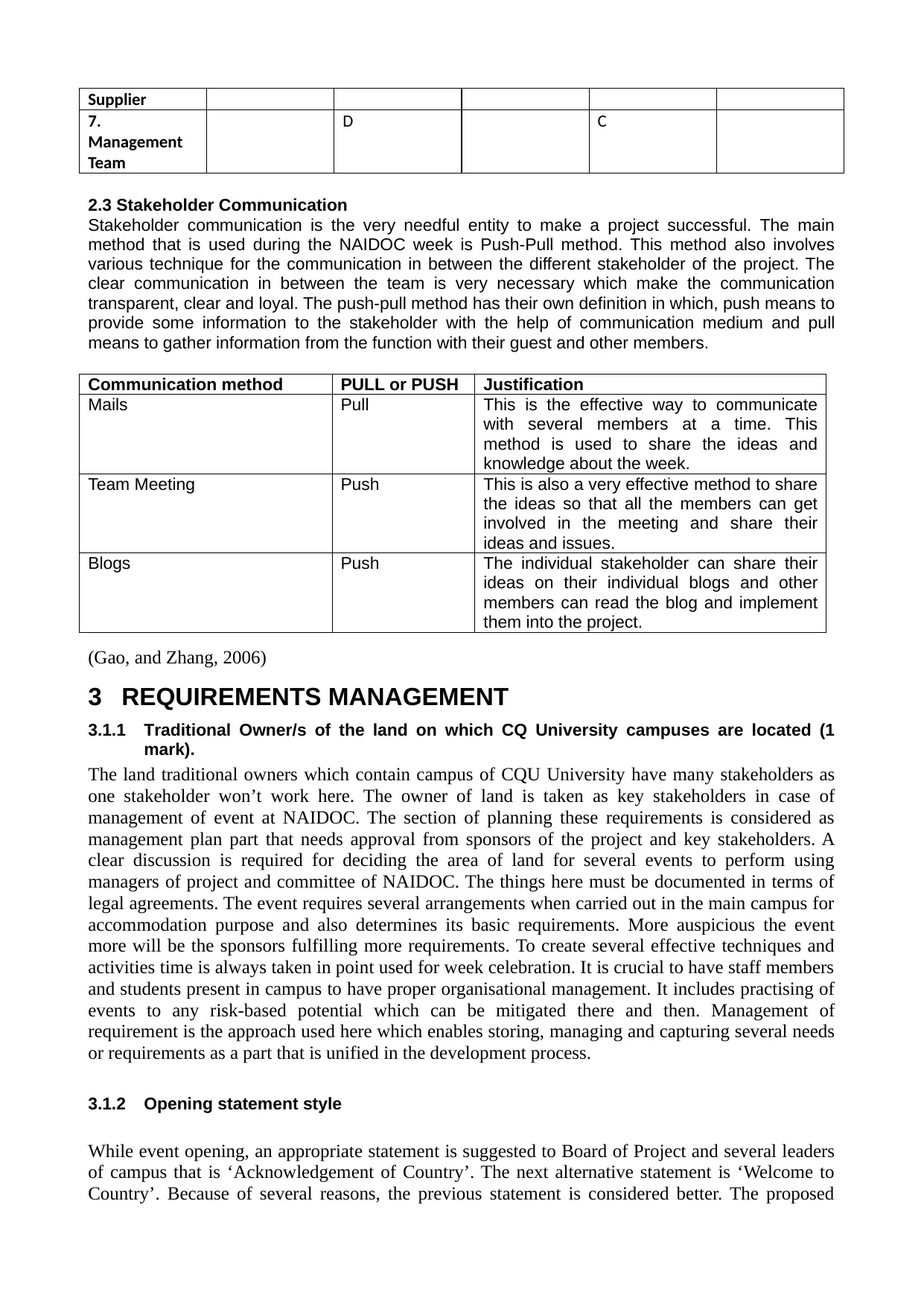
Supplier
7.
Management
Team
D C
2.3 Stakeholder Communication
Stakeholder communication is the very needful entity to make a project successful. The main
method that is used during the NAIDOC week is Push-Pull method. This method also involves
various technique for the communication in between the different stakeholder of the project. The
clear communication in between the team is very necessary which make the communication
transparent, clear and loyal. The push-pull method has their own definition in which, push means to
provide some information to the stakeholder with the help of communication medium and pull
means to gather information from the function with their guest and other members.
Communication method PULL or PUSH Justification
Mails Pull This is the effective way to communicate
with several members at a time. This
method is used to share the ideas and
knowledge about the week.
Team Meeting Push This is also a very effective method to share
the ideas so that all the members can get
involved in the meeting and share their
ideas and issues.
Blogs Push The individual stakeholder can share their
ideas on their individual blogs and other
members can read the blog and implement
them into the project.
(Gao, and Zhang, 2006)
3 REQUIREMENTS MANAGEMENT
3.1.1 Traditional Owner/s of the land on which CQ University campuses are located (1
mark).
The land traditional owners which contain campus of CQU University have many stakeholders as
one stakeholder won’t work here. The owner of land is taken as key stakeholders in case of
management of event at NAIDOC. The section of planning these requirements is considered as
management plan part that needs approval from sponsors of the project and key stakeholders. A
clear discussion is required for deciding the area of land for several events to perform using
managers of project and committee of NAIDOC. The things here must be documented in terms of
legal agreements. The event requires several arrangements when carried out in the main campus for
accommodation purpose and also determines its basic requirements. More auspicious the event
more will be the sponsors fulfilling more requirements. To create several effective techniques and
activities time is always taken in point used for week celebration. It is crucial to have staff members
and students present in campus to have proper organisational management. It includes practising of
events to any risk-based potential which can be mitigated there and then. Management of
requirement is the approach used here which enables storing, managing and capturing several needs
or requirements as a part that is unified in the development process.
3.1.2 Opening statement style
While event opening, an appropriate statement is suggested to Board of Project and several leaders
of campus that is ‘Acknowledgement of Country’. The next alternative statement is ‘Welcome to
Country’. Because of several reasons, the previous statement is considered better. The proposed
7.
Management
Team
D C
2.3 Stakeholder Communication
Stakeholder communication is the very needful entity to make a project successful. The main
method that is used during the NAIDOC week is Push-Pull method. This method also involves
various technique for the communication in between the different stakeholder of the project. The
clear communication in between the team is very necessary which make the communication
transparent, clear and loyal. The push-pull method has their own definition in which, push means to
provide some information to the stakeholder with the help of communication medium and pull
means to gather information from the function with their guest and other members.
Communication method PULL or PUSH Justification
Mails Pull This is the effective way to communicate
with several members at a time. This
method is used to share the ideas and
knowledge about the week.
Team Meeting Push This is also a very effective method to share
the ideas so that all the members can get
involved in the meeting and share their
ideas and issues.
Blogs Push The individual stakeholder can share their
ideas on their individual blogs and other
members can read the blog and implement
them into the project.
(Gao, and Zhang, 2006)
3 REQUIREMENTS MANAGEMENT
3.1.1 Traditional Owner/s of the land on which CQ University campuses are located (1
mark).
The land traditional owners which contain campus of CQU University have many stakeholders as
one stakeholder won’t work here. The owner of land is taken as key stakeholders in case of
management of event at NAIDOC. The section of planning these requirements is considered as
management plan part that needs approval from sponsors of the project and key stakeholders. A
clear discussion is required for deciding the area of land for several events to perform using
managers of project and committee of NAIDOC. The things here must be documented in terms of
legal agreements. The event requires several arrangements when carried out in the main campus for
accommodation purpose and also determines its basic requirements. More auspicious the event
more will be the sponsors fulfilling more requirements. To create several effective techniques and
activities time is always taken in point used for week celebration. It is crucial to have staff members
and students present in campus to have proper organisational management. It includes practising of
events to any risk-based potential which can be mitigated there and then. Management of
requirement is the approach used here which enables storing, managing and capturing several needs
or requirements as a part that is unified in the development process.
3.1.2 Opening statement style
While event opening, an appropriate statement is suggested to Board of Project and several leaders
of campus that is ‘Acknowledgement of Country’. The next alternative statement is ‘Welcome to
Country’. Because of several reasons, the previous statement is considered better. The proposed
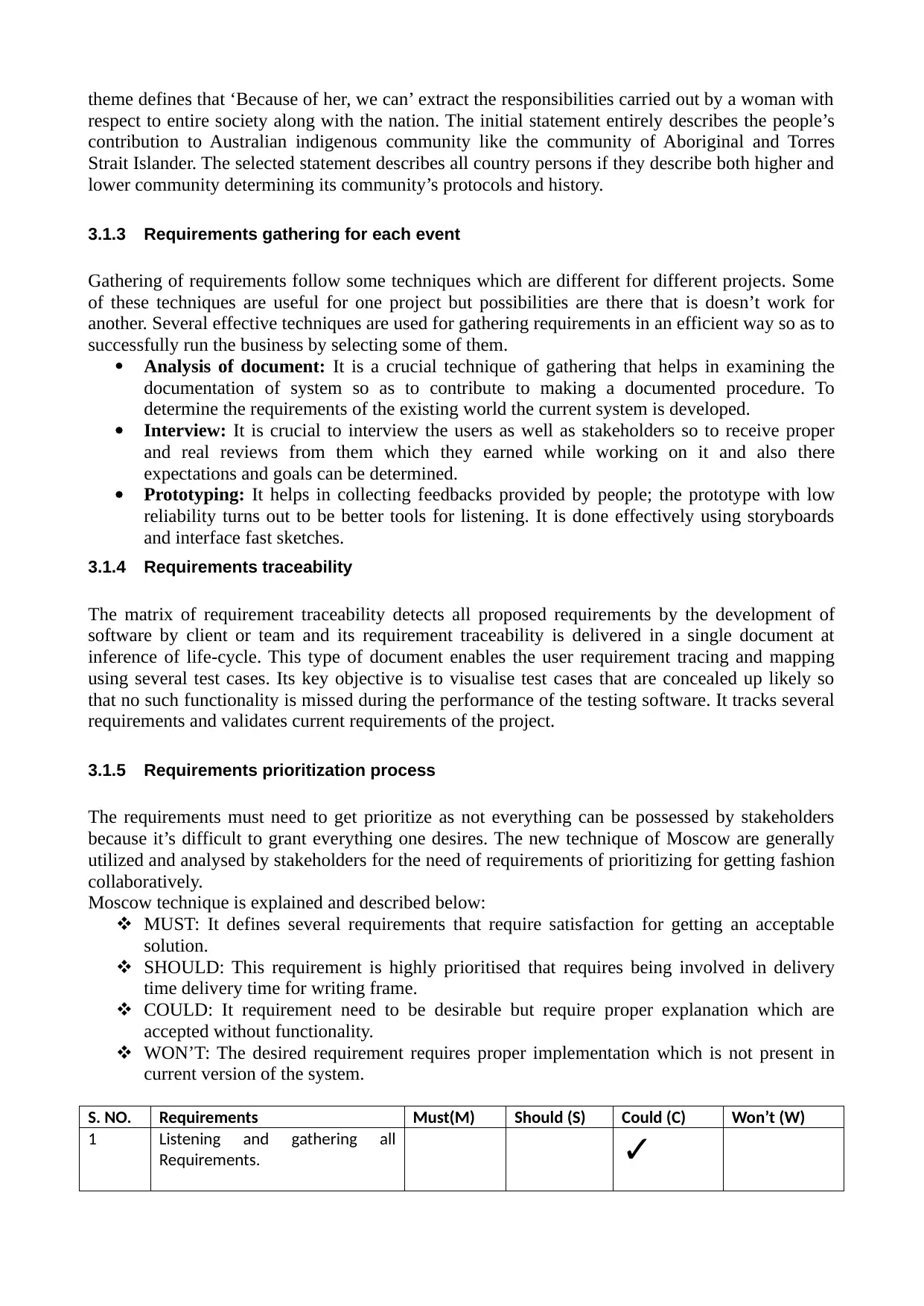
theme defines that ‘Because of her, we can’ extract the responsibilities carried out by a woman with
respect to entire society along with the nation. The initial statement entirely describes the people’s
contribution to Australian indigenous community like the community of Aboriginal and Torres
Strait Islander. The selected statement describes all country persons if they describe both higher and
lower community determining its community’s protocols and history.
3.1.3 Requirements gathering for each event
Gathering of requirements follow some techniques which are different for different projects. Some
of these techniques are useful for one project but possibilities are there that is doesn’t work for
another. Several effective techniques are used for gathering requirements in an efficient way so as to
successfully run the business by selecting some of them.
Analysis of document: It is a crucial technique of gathering that helps in examining the
documentation of system so as to contribute to making a documented procedure. To
determine the requirements of the existing world the current system is developed.
Interview: It is crucial to interview the users as well as stakeholders so to receive proper
and real reviews from them which they earned while working on it and also there
expectations and goals can be determined.
Prototyping: It helps in collecting feedbacks provided by people; the prototype with low
reliability turns out to be better tools for listening. It is done effectively using storyboards
and interface fast sketches.
3.1.4 Requirements traceability
The matrix of requirement traceability detects all proposed requirements by the development of
software by client or team and its requirement traceability is delivered in a single document at
inference of life-cycle. This type of document enables the user requirement tracing and mapping
using several test cases. Its key objective is to visualise test cases that are concealed up likely so
that no such functionality is missed during the performance of the testing software. It tracks several
requirements and validates current requirements of the project.
3.1.5 Requirements prioritization process
The requirements must need to get prioritize as not everything can be possessed by stakeholders
because it’s difficult to grant everything one desires. The new technique of Moscow are generally
utilized and analysed by stakeholders for the need of requirements of prioritizing for getting fashion
collaboratively.
Moscow technique is explained and described below:
MUST: It defines several requirements that require satisfaction for getting an acceptable
solution.
SHOULD: This requirement is highly prioritised that requires being involved in delivery
time delivery time for writing frame.
COULD: It requirement need to be desirable but require proper explanation which are
accepted without functionality.
WON’T: The desired requirement requires proper implementation which is not present in
current version of the system.
S. NO. Requirements Must(M) Should (S) Could (C) Won’t (W)
1 Listening and gathering all
Requirements. ✓
respect to entire society along with the nation. The initial statement entirely describes the people’s
contribution to Australian indigenous community like the community of Aboriginal and Torres
Strait Islander. The selected statement describes all country persons if they describe both higher and
lower community determining its community’s protocols and history.
3.1.3 Requirements gathering for each event
Gathering of requirements follow some techniques which are different for different projects. Some
of these techniques are useful for one project but possibilities are there that is doesn’t work for
another. Several effective techniques are used for gathering requirements in an efficient way so as to
successfully run the business by selecting some of them.
Analysis of document: It is a crucial technique of gathering that helps in examining the
documentation of system so as to contribute to making a documented procedure. To
determine the requirements of the existing world the current system is developed.
Interview: It is crucial to interview the users as well as stakeholders so to receive proper
and real reviews from them which they earned while working on it and also there
expectations and goals can be determined.
Prototyping: It helps in collecting feedbacks provided by people; the prototype with low
reliability turns out to be better tools for listening. It is done effectively using storyboards
and interface fast sketches.
3.1.4 Requirements traceability
The matrix of requirement traceability detects all proposed requirements by the development of
software by client or team and its requirement traceability is delivered in a single document at
inference of life-cycle. This type of document enables the user requirement tracing and mapping
using several test cases. Its key objective is to visualise test cases that are concealed up likely so
that no such functionality is missed during the performance of the testing software. It tracks several
requirements and validates current requirements of the project.
3.1.5 Requirements prioritization process
The requirements must need to get prioritize as not everything can be possessed by stakeholders
because it’s difficult to grant everything one desires. The new technique of Moscow are generally
utilized and analysed by stakeholders for the need of requirements of prioritizing for getting fashion
collaboratively.
Moscow technique is explained and described below:
MUST: It defines several requirements that require satisfaction for getting an acceptable
solution.
SHOULD: This requirement is highly prioritised that requires being involved in delivery
time delivery time for writing frame.
COULD: It requirement need to be desirable but require proper explanation which are
accepted without functionality.
WON’T: The desired requirement requires proper implementation which is not present in
current version of the system.
S. NO. Requirements Must(M) Should (S) Could (C) Won’t (W)
1 Listening and gathering all
Requirements. ✓
Paraphrase This Document
Need a fresh take? Get an instant paraphrase of this document with our AI Paraphraser
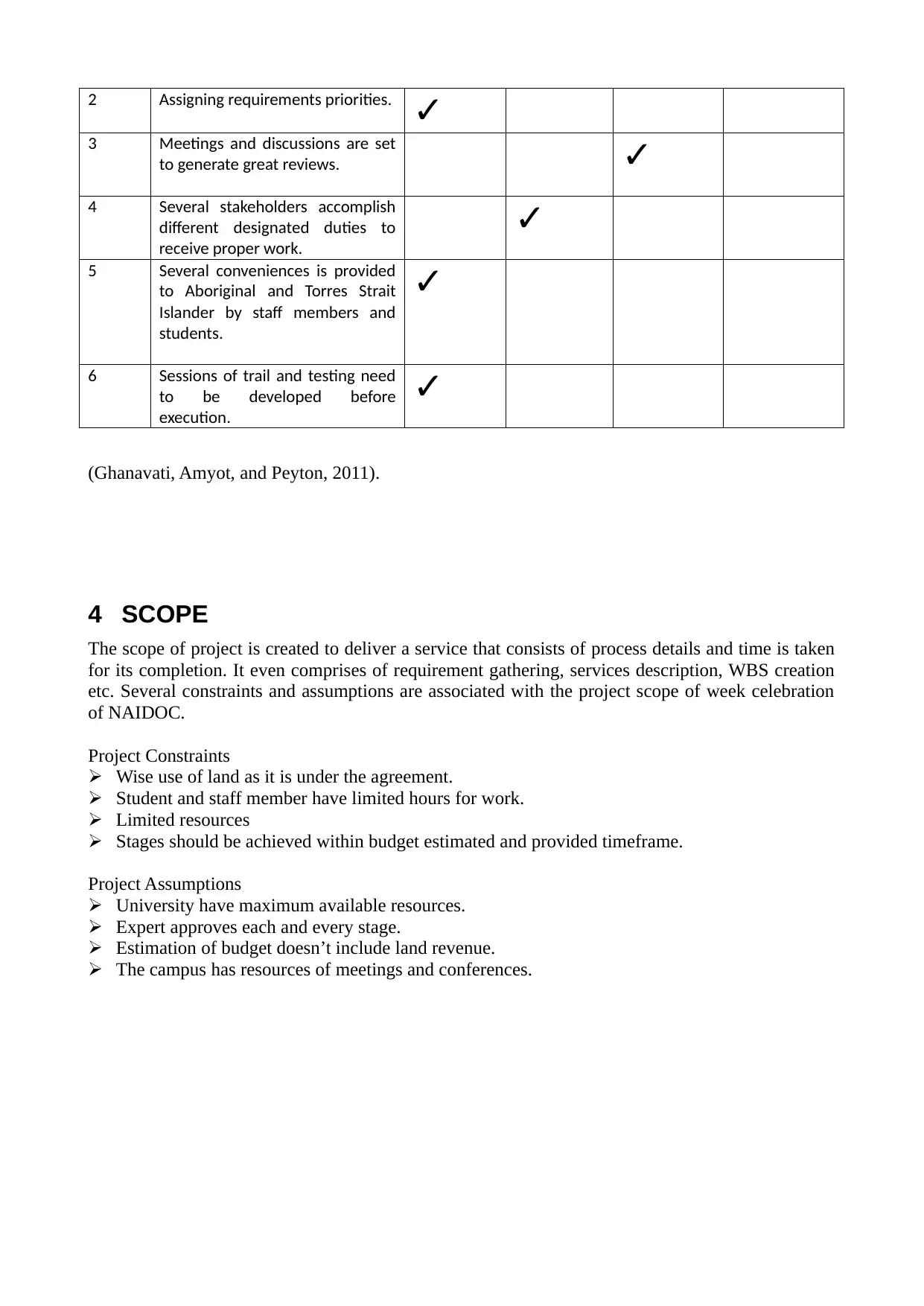
2 Assigning requirements priorities.
✓
3 Meetings and discussions are set
to generate great reviews. ✓
4 Several stakeholders accomplish
different designated duties to
receive proper work.
✓
5 Several conveniences is provided
to Aboriginal and Torres Strait
Islander by staff members and
students.
✓
6 Sessions of trail and testing need
to be developed before
execution.
✓
(Ghanavati, Amyot, and Peyton, 2011).
4 SCOPE
The scope of project is created to deliver a service that consists of process details and time is taken
for its completion. It even comprises of requirement gathering, services description, WBS creation
etc. Several constraints and assumptions are associated with the project scope of week celebration
of NAIDOC.
Project Constraints
Wise use of land as it is under the agreement.
Student and staff member have limited hours for work.
Limited resources
Stages should be achieved within budget estimated and provided timeframe.
Project Assumptions
University have maximum available resources.
Expert approves each and every stage.
Estimation of budget doesn’t include land revenue.
The campus has resources of meetings and conferences.
✓
3 Meetings and discussions are set
to generate great reviews. ✓
4 Several stakeholders accomplish
different designated duties to
receive proper work.
✓
5 Several conveniences is provided
to Aboriginal and Torres Strait
Islander by staff members and
students.
✓
6 Sessions of trail and testing need
to be developed before
execution.
✓
(Ghanavati, Amyot, and Peyton, 2011).
4 SCOPE
The scope of project is created to deliver a service that consists of process details and time is taken
for its completion. It even comprises of requirement gathering, services description, WBS creation
etc. Several constraints and assumptions are associated with the project scope of week celebration
of NAIDOC.
Project Constraints
Wise use of land as it is under the agreement.
Student and staff member have limited hours for work.
Limited resources
Stages should be achieved within budget estimated and provided timeframe.
Project Assumptions
University have maximum available resources.
Expert approves each and every stage.
Estimation of budget doesn’t include land revenue.
The campus has resources of meetings and conferences.
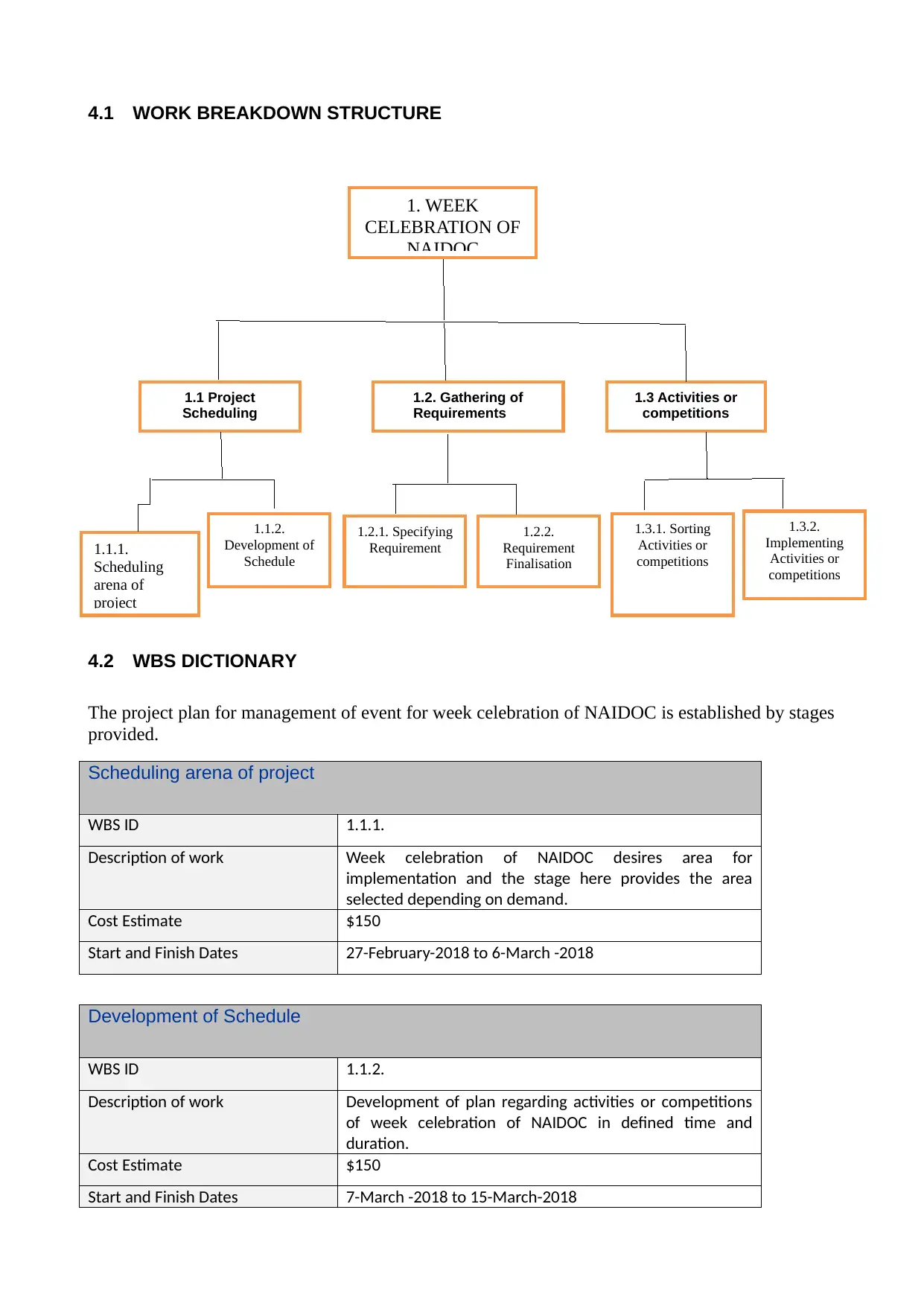
4.1 WORK BREAKDOWN STRUCTURE
4.2 WBS DICTIONARY
The project plan for management of event for week celebration of NAIDOC is established by stages
provided.
Scheduling arena of project
WBS ID 1.1.1.
Description of work Week celebration of NAIDOC desires area for
implementation and the stage here provides the area
selected depending on demand.
Cost Estimate $150
Start and Finish Dates 27-February-2018 to 6-March -2018
Development of Schedule
WBS ID 1.1.2.
Description of work Development of plan regarding activities or competitions
of week celebration of NAIDOC in defined time and
duration.
Cost Estimate $150
Start and Finish Dates 7-March -2018 to 15-March-2018
1.2. Gathering of
Requirements
1.3 Activities or
competitions
1.1 Project
Scheduling
1.1.2.
Development of
Schedule
1.1.1.
Scheduling
arena of
project
1.2.1. Specifying
Requirement
1.2.2.
Requirement
Finalisation
1.3.1. Sorting
Activities or
competitions
1.3.2.
Implementing
Activities or
competitions
1. WEEK
CELEBRATION OF
NAIDOC
4.2 WBS DICTIONARY
The project plan for management of event for week celebration of NAIDOC is established by stages
provided.
Scheduling arena of project
WBS ID 1.1.1.
Description of work Week celebration of NAIDOC desires area for
implementation and the stage here provides the area
selected depending on demand.
Cost Estimate $150
Start and Finish Dates 27-February-2018 to 6-March -2018
Development of Schedule
WBS ID 1.1.2.
Description of work Development of plan regarding activities or competitions
of week celebration of NAIDOC in defined time and
duration.
Cost Estimate $150
Start and Finish Dates 7-March -2018 to 15-March-2018
1.2. Gathering of
Requirements
1.3 Activities or
competitions
1.1 Project
Scheduling
1.1.2.
Development of
Schedule
1.1.1.
Scheduling
arena of
project
1.2.1. Specifying
Requirement
1.2.2.
Requirement
Finalisation
1.3.1. Sorting
Activities or
competitions
1.3.2.
Implementing
Activities or
competitions
1. WEEK
CELEBRATION OF
NAIDOC
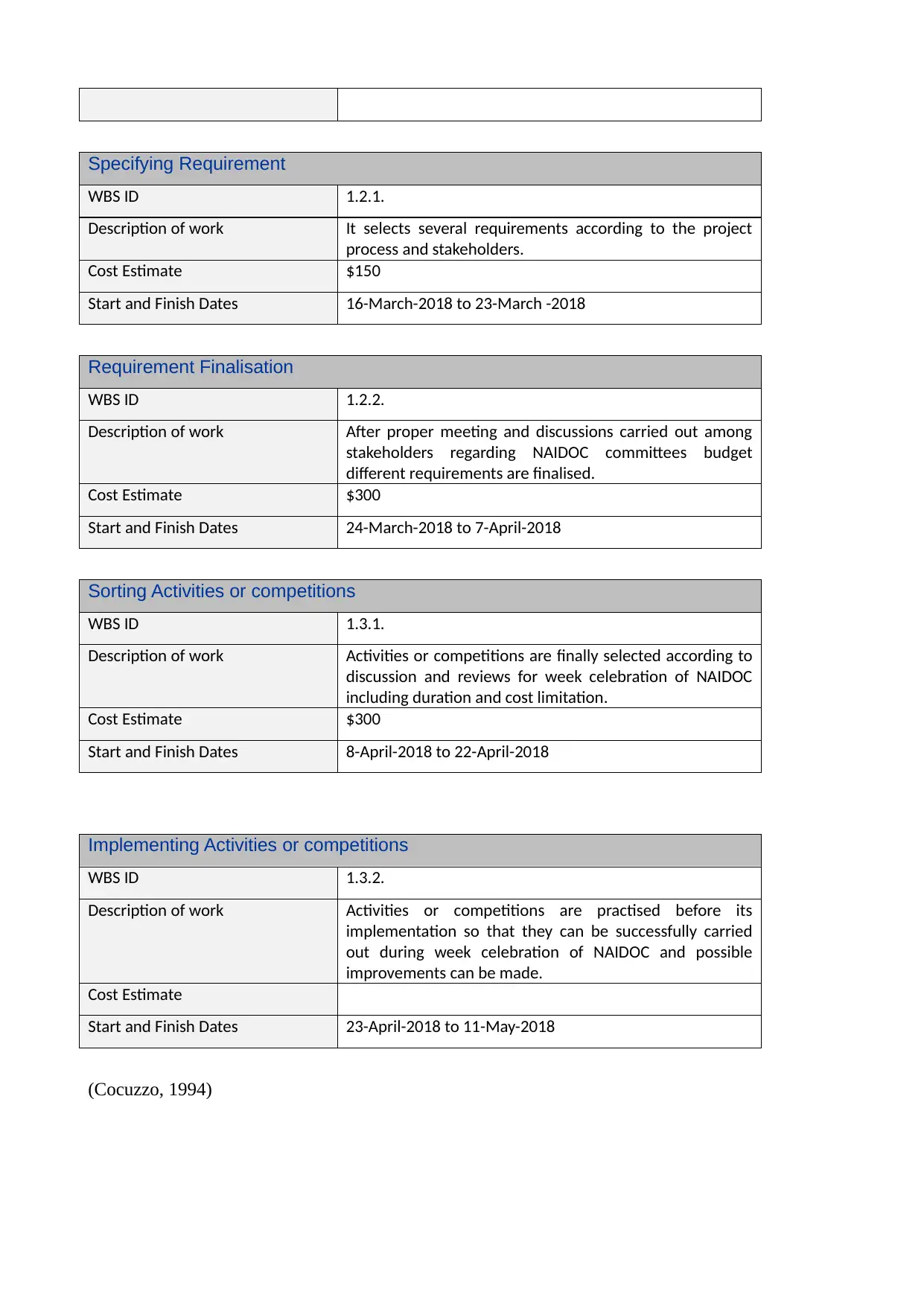
Specifying Requirement
WBS ID 1.2.1.
Description of work It selects several requirements according to the project
process and stakeholders.
Cost Estimate $150
Start and Finish Dates 16-March-2018 to 23-March -2018
Requirement Finalisation
WBS ID 1.2.2.
Description of work After proper meeting and discussions carried out among
stakeholders regarding NAIDOC committees budget
different requirements are finalised.
Cost Estimate $300
Start and Finish Dates 24-March-2018 to 7-April-2018
Sorting Activities or competitions
WBS ID 1.3.1.
Description of work Activities or competitions are finally selected according to
discussion and reviews for week celebration of NAIDOC
including duration and cost limitation.
Cost Estimate $300
Start and Finish Dates 8-April-2018 to 22-April-2018
Implementing Activities or competitions
WBS ID 1.3.2.
Description of work Activities or competitions are practised before its
implementation so that they can be successfully carried
out during week celebration of NAIDOC and possible
improvements can be made.
Cost Estimate
Start and Finish Dates 23-April-2018 to 11-May-2018
(Cocuzzo, 1994)
WBS ID 1.2.1.
Description of work It selects several requirements according to the project
process and stakeholders.
Cost Estimate $150
Start and Finish Dates 16-March-2018 to 23-March -2018
Requirement Finalisation
WBS ID 1.2.2.
Description of work After proper meeting and discussions carried out among
stakeholders regarding NAIDOC committees budget
different requirements are finalised.
Cost Estimate $300
Start and Finish Dates 24-March-2018 to 7-April-2018
Sorting Activities or competitions
WBS ID 1.3.1.
Description of work Activities or competitions are finally selected according to
discussion and reviews for week celebration of NAIDOC
including duration and cost limitation.
Cost Estimate $300
Start and Finish Dates 8-April-2018 to 22-April-2018
Implementing Activities or competitions
WBS ID 1.3.2.
Description of work Activities or competitions are practised before its
implementation so that they can be successfully carried
out during week celebration of NAIDOC and possible
improvements can be made.
Cost Estimate
Start and Finish Dates 23-April-2018 to 11-May-2018
(Cocuzzo, 1994)
Secure Best Marks with AI Grader
Need help grading? Try our AI Grader for instant feedback on your assignments.
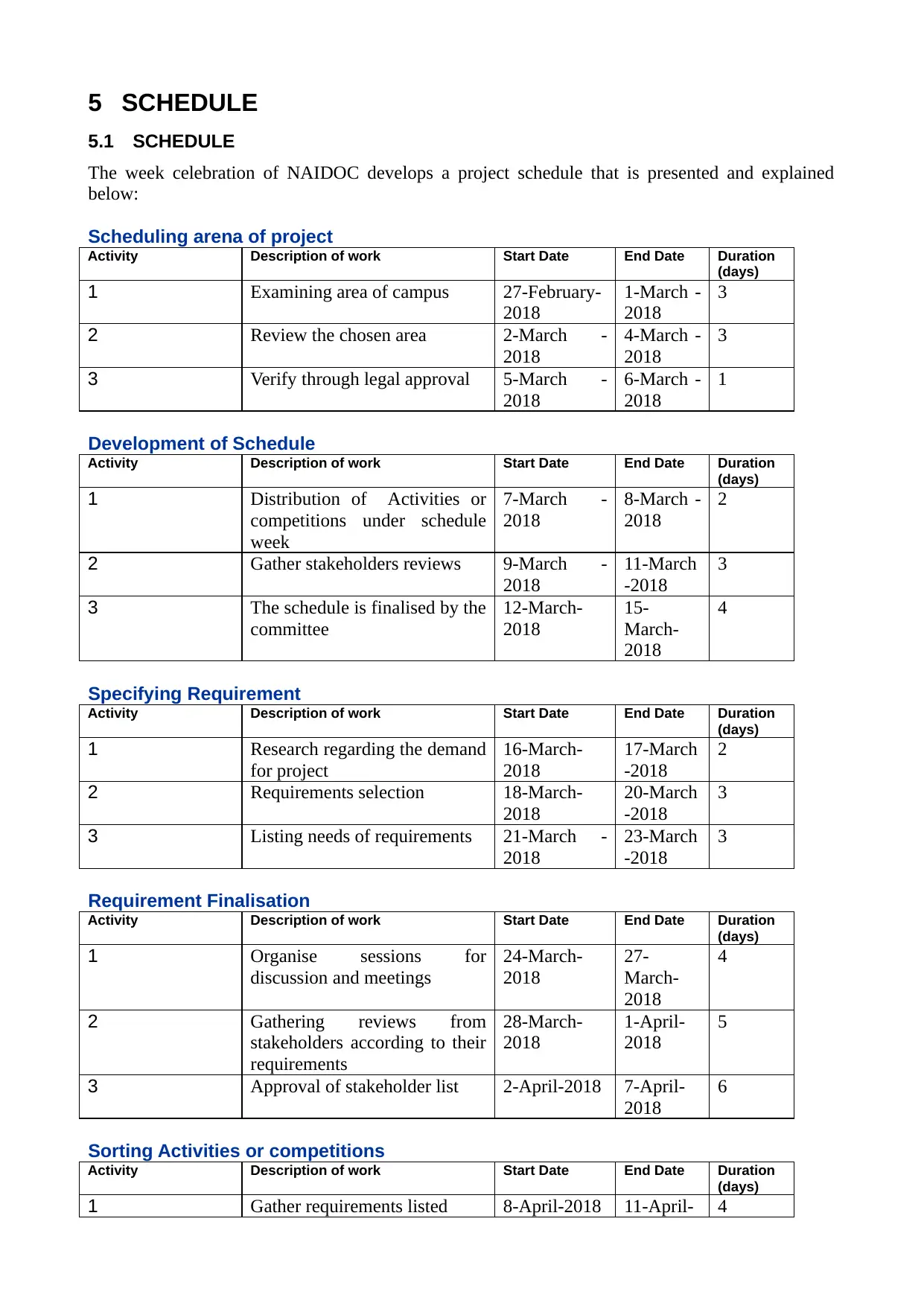
5 SCHEDULE
5.1 SCHEDULE
The week celebration of NAIDOC develops a project schedule that is presented and explained
below:
Scheduling arena of project
Activity Description of work Start Date End Date Duration
(days)
1 Examining area of campus 27-February-
2018
1-March -
2018
3
2 Review the chosen area 2-March -
2018
4-March -
2018
3
3 Verify through legal approval 5-March -
2018
6-March -
2018
1
Development of Schedule
Activity Description of work Start Date End Date Duration
(days)
1 Distribution of Activities or
competitions under schedule
week
7-March -
2018
8-March -
2018
2
2 Gather stakeholders reviews 9-March -
2018
11-March
-2018
3
3 The schedule is finalised by the
committee
12-March-
2018
15-
March-
2018
4
Specifying Requirement
Activity Description of work Start Date End Date Duration
(days)
1 Research regarding the demand
for project
16-March-
2018
17-March
-2018
2
2 Requirements selection 18-March-
2018
20-March
-2018
3
3 Listing needs of requirements 21-March -
2018
23-March
-2018
3
Requirement Finalisation
Activity Description of work Start Date End Date Duration
(days)
1 Organise sessions for
discussion and meetings
24-March-
2018
27-
March-
2018
4
2 Gathering reviews from
stakeholders according to their
requirements
28-March-
2018
1-April-
2018
5
3 Approval of stakeholder list 2-April-2018 7-April-
2018
6
Sorting Activities or competitions
Activity Description of work Start Date End Date Duration
(days)
1 Gather requirements listed 8-April-2018 11-April- 4
5.1 SCHEDULE
The week celebration of NAIDOC develops a project schedule that is presented and explained
below:
Scheduling arena of project
Activity Description of work Start Date End Date Duration
(days)
1 Examining area of campus 27-February-
2018
1-March -
2018
3
2 Review the chosen area 2-March -
2018
4-March -
2018
3
3 Verify through legal approval 5-March -
2018
6-March -
2018
1
Development of Schedule
Activity Description of work Start Date End Date Duration
(days)
1 Distribution of Activities or
competitions under schedule
week
7-March -
2018
8-March -
2018
2
2 Gather stakeholders reviews 9-March -
2018
11-March
-2018
3
3 The schedule is finalised by the
committee
12-March-
2018
15-
March-
2018
4
Specifying Requirement
Activity Description of work Start Date End Date Duration
(days)
1 Research regarding the demand
for project
16-March-
2018
17-March
-2018
2
2 Requirements selection 18-March-
2018
20-March
-2018
3
3 Listing needs of requirements 21-March -
2018
23-March
-2018
3
Requirement Finalisation
Activity Description of work Start Date End Date Duration
(days)
1 Organise sessions for
discussion and meetings
24-March-
2018
27-
March-
2018
4
2 Gathering reviews from
stakeholders according to their
requirements
28-March-
2018
1-April-
2018
5
3 Approval of stakeholder list 2-April-2018 7-April-
2018
6
Sorting Activities or competitions
Activity Description of work Start Date End Date Duration
(days)
1 Gather requirements listed 8-April-2018 11-April- 4
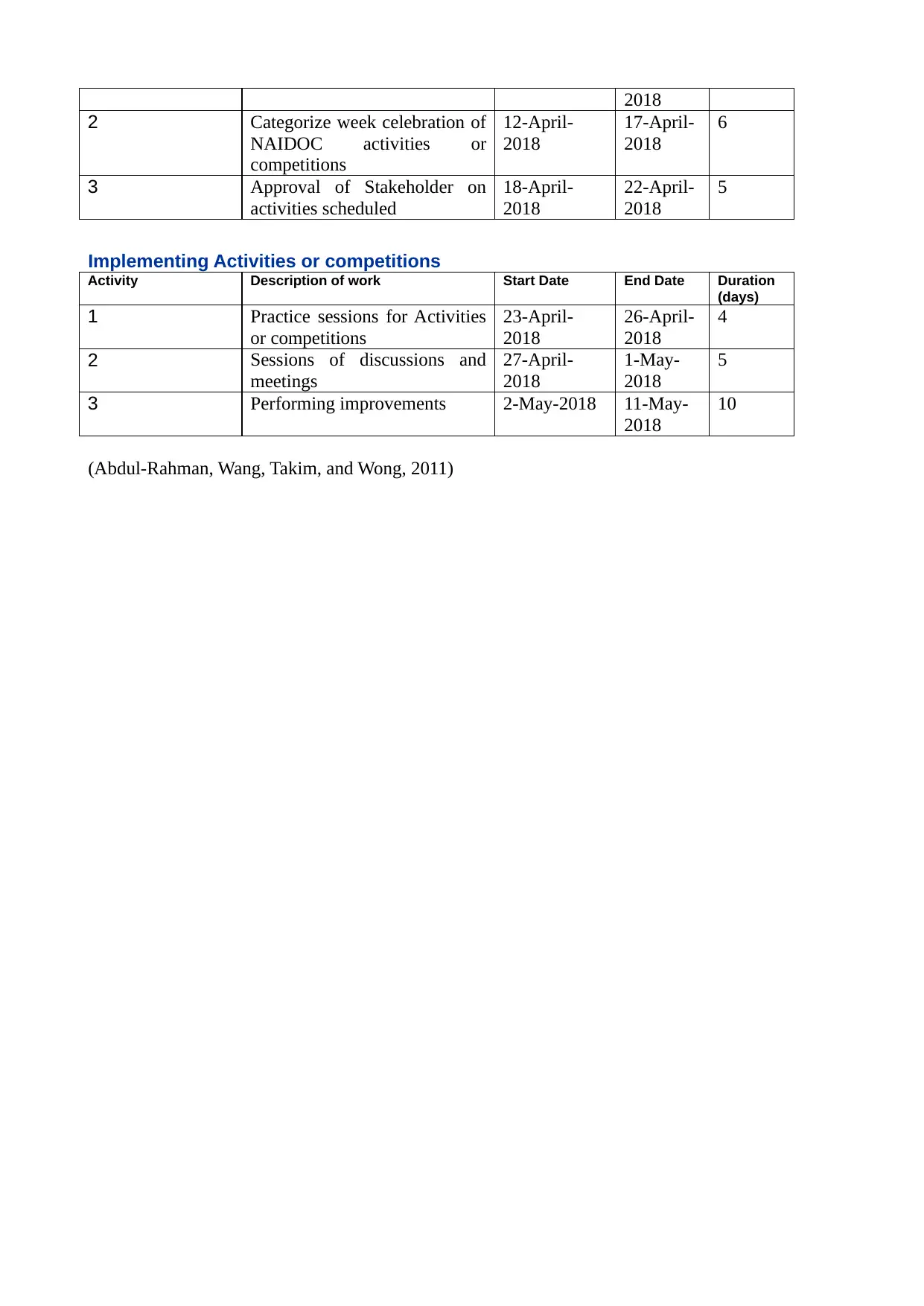
2018
2 Categorize week celebration of
NAIDOC activities or
competitions
12-April-
2018
17-April-
2018
6
3 Approval of Stakeholder on
activities scheduled
18-April-
2018
22-April-
2018
5
Implementing Activities or competitions
Activity Description of work Start Date End Date Duration
(days)
1 Practice sessions for Activities
or competitions
23-April-
2018
26-April-
2018
4
2 Sessions of discussions and
meetings
27-April-
2018
1-May-
2018
5
3 Performing improvements 2-May-2018 11-May-
2018
10
(Abdul-Rahman, Wang, Takim, and Wong, 2011)
2 Categorize week celebration of
NAIDOC activities or
competitions
12-April-
2018
17-April-
2018
6
3 Approval of Stakeholder on
activities scheduled
18-April-
2018
22-April-
2018
5
Implementing Activities or competitions
Activity Description of work Start Date End Date Duration
(days)
1 Practice sessions for Activities
or competitions
23-April-
2018
26-April-
2018
4
2 Sessions of discussions and
meetings
27-April-
2018
1-May-
2018
5
3 Performing improvements 2-May-2018 11-May-
2018
10
(Abdul-Rahman, Wang, Takim, and Wong, 2011)

6 COST BASELINE
This is the baseline that tells about the overall cost of the project also it also gives a brief idea that
how much cost is needed at the initial level of the project. The community defines the cost and
budget by discussing with NAIDOC community. Per week cost baseline is described as follows:
Estimated Cost per week = $150
Estimated cost per day = $21.42
Estimate cost per hour (7 hours/day) = $3
Weeks
WBS
id
1 2 3 4 5 6 7 8 9 10
1.1.1 Scheduling
arena of
project
$1
50
1.1.2 Development
of Schedule
$165 $5
1.2.1 Specifying
Requirement
$170 $5
1.2.2 Requirement
Finalization
$5 $135 $130
1.3.1 Sorting
Activities or
competitions
$5 $7
0
$7
5
$60
1.3.2 Implementin
g Activities
or
competitions
$5 $45 $5
0
Total weekly
cost
$1
50
$150 $150 $150 $150 $1
50
$1
50
$150 $150 $1
50
Cumulative
cost
$1
50
$170 $170 $140 $135 $7
0
$8
0
$60 $45 $5
0
This is the baseline that tells about the overall cost of the project also it also gives a brief idea that
how much cost is needed at the initial level of the project. The community defines the cost and
budget by discussing with NAIDOC community. Per week cost baseline is described as follows:
Estimated Cost per week = $150
Estimated cost per day = $21.42
Estimate cost per hour (7 hours/day) = $3
Weeks
WBS
id
1 2 3 4 5 6 7 8 9 10
1.1.1 Scheduling
arena of
project
$1
50
1.1.2 Development
of Schedule
$165 $5
1.2.1 Specifying
Requirement
$170 $5
1.2.2 Requirement
Finalization
$5 $135 $130
1.3.1 Sorting
Activities or
competitions
$5 $7
0
$7
5
$60
1.3.2 Implementin
g Activities
or
competitions
$5 $45 $5
0
Total weekly
cost
$1
50
$150 $150 $150 $150 $1
50
$1
50
$150 $150 $1
50
Cumulative
cost
$1
50
$170 $170 $140 $135 $7
0
$8
0
$60 $45 $5
0
Paraphrase This Document
Need a fresh take? Get an instant paraphrase of this document with our AI Paraphraser

7 RISKS
Risk Register
The different threats are opportunity associated with the project is described below. The risk
assessment is done to get the knowledge of the risk and their counterpart to stop them.
Risk Register
Name Description Likelihoo
d
Impact Response
type
Mitigation strategy
Threat 1. Overlay of
Budget
Moderate This will make a
loss on CQU
university.
Finance The proper management of the
activities with their planned
requirements. Proper skills in
the project team.
2. Delay in
project
Low The events of
the week get
miss-managed
or delayed.
Time loss Proper flow plan for all the
activities with proper allocation
of team and resources. Plan B
is ready in case plan A get
failed.
3. Improper
Meetings
Low Improper
information is
circulated In the
team.
Time and
Cost loss.
Provide a basic outline for every
meeting that what are the topics
are going to be discussed in
that particular meeting.
4. Improper
requirement
selection
Moderate The wrong
requirements are
selected for the
function which
increases the
overall cost of
the project.
Cost Proper planning at the start of
the project so that the project
team should pass an
appropriate budget without any
loss in the cost.
Opportunity Staff and
student get
advantages to
know about
the culture of
Australian
traits.
High The Student gets
knowledge about
the culture which
is not possible
from theoretical
knowledge.
Quality and
ethics
learning
They can take their contact
details to make communication
after the event in case of any
issue.
(Hu, et-al, 2013)
8 TOLERANCES
This is the extra time that is taken after the scheduled time to complete the project so that the
project will be completed on correct time without any disturbance. The tolerance time and cost that
is defined for the NAIDOC week is as follows:
Tolerance Specific Tolerance allowed
Tolerance specified for the time 3 Days
Tolerance specified for cost $550 - $650
9 LESSONS
Previous lessons learned Proposed activity to address
(in the current project)
Work package which
activity will be added
Lesson
The all task are divided into various
The activity that is proposed for
the learning purpose is
The project stage includes a
project work package that is
Risk Register
The different threats are opportunity associated with the project is described below. The risk
assessment is done to get the knowledge of the risk and their counterpart to stop them.
Risk Register
Name Description Likelihoo
d
Impact Response
type
Mitigation strategy
Threat 1. Overlay of
Budget
Moderate This will make a
loss on CQU
university.
Finance The proper management of the
activities with their planned
requirements. Proper skills in
the project team.
2. Delay in
project
Low The events of
the week get
miss-managed
or delayed.
Time loss Proper flow plan for all the
activities with proper allocation
of team and resources. Plan B
is ready in case plan A get
failed.
3. Improper
Meetings
Low Improper
information is
circulated In the
team.
Time and
Cost loss.
Provide a basic outline for every
meeting that what are the topics
are going to be discussed in
that particular meeting.
4. Improper
requirement
selection
Moderate The wrong
requirements are
selected for the
function which
increases the
overall cost of
the project.
Cost Proper planning at the start of
the project so that the project
team should pass an
appropriate budget without any
loss in the cost.
Opportunity Staff and
student get
advantages to
know about
the culture of
Australian
traits.
High The Student gets
knowledge about
the culture which
is not possible
from theoretical
knowledge.
Quality and
ethics
learning
They can take their contact
details to make communication
after the event in case of any
issue.
(Hu, et-al, 2013)
8 TOLERANCES
This is the extra time that is taken after the scheduled time to complete the project so that the
project will be completed on correct time without any disturbance. The tolerance time and cost that
is defined for the NAIDOC week is as follows:
Tolerance Specific Tolerance allowed
Tolerance specified for the time 3 Days
Tolerance specified for cost $550 - $650
9 LESSONS
Previous lessons learned Proposed activity to address
(in the current project)
Work package which
activity will be added
Lesson
The all task are divided into various
The activity that is proposed for
the learning purpose is
The project stage includes a
project work package that is
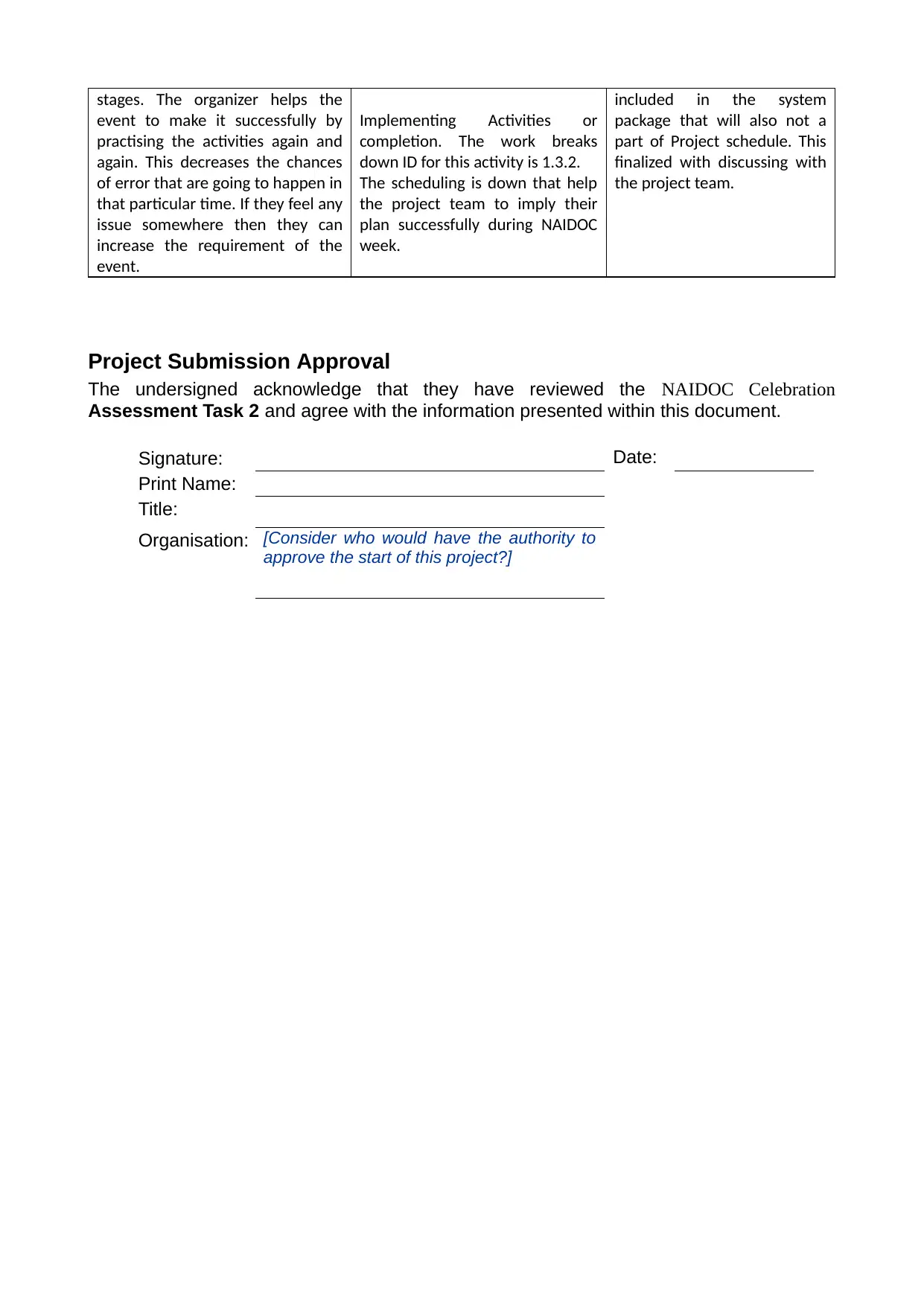
stages. The organizer helps the
event to make it successfully by
practising the activities again and
again. This decreases the chances
of error that are going to happen in
that particular time. If they feel any
issue somewhere then they can
increase the requirement of the
event.
Implementing Activities or
completion. The work breaks
down ID for this activity is 1.3.2.
The scheduling is down that help
the project team to imply their
plan successfully during NAIDOC
week.
included in the system
package that will also not a
part of Project schedule. This
finalized with discussing with
the project team.
Project Submission Approval
The undersigned acknowledge that they have reviewed the NAIDOC Celebration
Assessment Task 2 and agree with the information presented within this document.
Signature: Date:
Print Name:
Title:
Organisation: [Consider who would have the authority to
approve the start of this project?]
event to make it successfully by
practising the activities again and
again. This decreases the chances
of error that are going to happen in
that particular time. If they feel any
issue somewhere then they can
increase the requirement of the
event.
Implementing Activities or
completion. The work breaks
down ID for this activity is 1.3.2.
The scheduling is down that help
the project team to imply their
plan successfully during NAIDOC
week.
included in the system
package that will also not a
part of Project schedule. This
finalized with discussing with
the project team.
Project Submission Approval
The undersigned acknowledge that they have reviewed the NAIDOC Celebration
Assessment Task 2 and agree with the information presented within this document.
Signature: Date:
Print Name:
Title:
Organisation: [Consider who would have the authority to
approve the start of this project?]
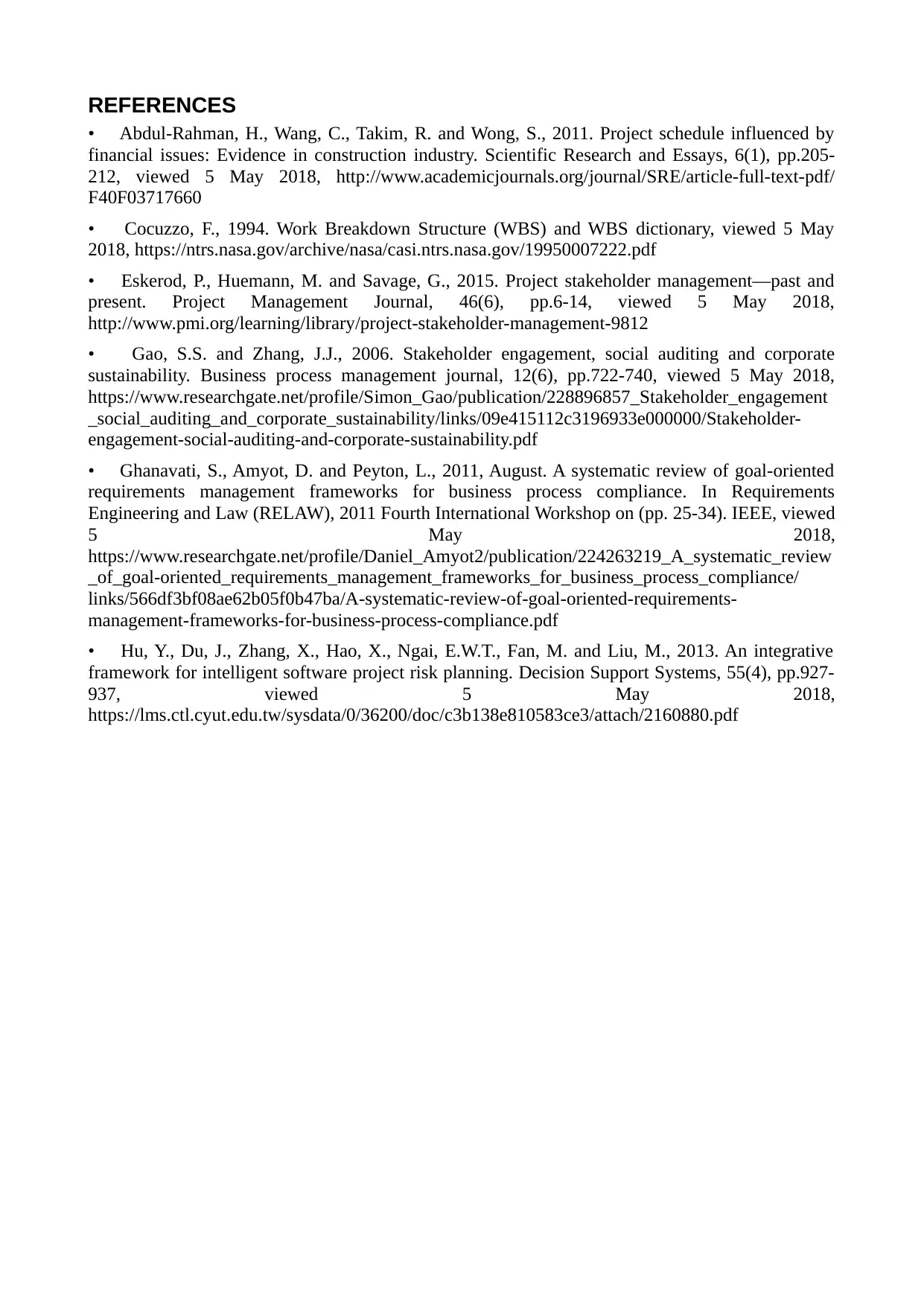
REFERENCES
• Abdul-Rahman, H., Wang, C., Takim, R. and Wong, S., 2011. Project schedule influenced by
financial issues: Evidence in construction industry. Scientific Research and Essays, 6(1), pp.205-
212, viewed 5 May 2018, http://www.academicjournals.org/journal/SRE/article-full-text-pdf/
F40F03717660
• Cocuzzo, F., 1994. Work Breakdown Structure (WBS) and WBS dictionary, viewed 5 May
2018, https://ntrs.nasa.gov/archive/nasa/casi.ntrs.nasa.gov/19950007222.pdf
• Eskerod, P., Huemann, M. and Savage, G., 2015. Project stakeholder management—past and
present. Project Management Journal, 46(6), pp.6-14, viewed 5 May 2018,
http://www.pmi.org/learning/library/project-stakeholder-management-9812
• Gao, S.S. and Zhang, J.J., 2006. Stakeholder engagement, social auditing and corporate
sustainability. Business process management journal, 12(6), pp.722-740, viewed 5 May 2018,
https://www.researchgate.net/profile/Simon_Gao/publication/228896857_Stakeholder_engagement
_social_auditing_and_corporate_sustainability/links/09e415112c3196933e000000/Stakeholder-
engagement-social-auditing-and-corporate-sustainability.pdf
• Ghanavati, S., Amyot, D. and Peyton, L., 2011, August. A systematic review of goal-oriented
requirements management frameworks for business process compliance. In Requirements
Engineering and Law (RELAW), 2011 Fourth International Workshop on (pp. 25-34). IEEE, viewed
5 May 2018,
https://www.researchgate.net/profile/Daniel_Amyot2/publication/224263219_A_systematic_review
_of_goal-oriented_requirements_management_frameworks_for_business_process_compliance/
links/566df3bf08ae62b05f0b47ba/A-systematic-review-of-goal-oriented-requirements-
management-frameworks-for-business-process-compliance.pdf
• Hu, Y., Du, J., Zhang, X., Hao, X., Ngai, E.W.T., Fan, M. and Liu, M., 2013. An integrative
framework for intelligent software project risk planning. Decision Support Systems, 55(4), pp.927-
937, viewed 5 May 2018,
https://lms.ctl.cyut.edu.tw/sysdata/0/36200/doc/c3b138e810583ce3/attach/2160880.pdf
• Abdul-Rahman, H., Wang, C., Takim, R. and Wong, S., 2011. Project schedule influenced by
financial issues: Evidence in construction industry. Scientific Research and Essays, 6(1), pp.205-
212, viewed 5 May 2018, http://www.academicjournals.org/journal/SRE/article-full-text-pdf/
F40F03717660
• Cocuzzo, F., 1994. Work Breakdown Structure (WBS) and WBS dictionary, viewed 5 May
2018, https://ntrs.nasa.gov/archive/nasa/casi.ntrs.nasa.gov/19950007222.pdf
• Eskerod, P., Huemann, M. and Savage, G., 2015. Project stakeholder management—past and
present. Project Management Journal, 46(6), pp.6-14, viewed 5 May 2018,
http://www.pmi.org/learning/library/project-stakeholder-management-9812
• Gao, S.S. and Zhang, J.J., 2006. Stakeholder engagement, social auditing and corporate
sustainability. Business process management journal, 12(6), pp.722-740, viewed 5 May 2018,
https://www.researchgate.net/profile/Simon_Gao/publication/228896857_Stakeholder_engagement
_social_auditing_and_corporate_sustainability/links/09e415112c3196933e000000/Stakeholder-
engagement-social-auditing-and-corporate-sustainability.pdf
• Ghanavati, S., Amyot, D. and Peyton, L., 2011, August. A systematic review of goal-oriented
requirements management frameworks for business process compliance. In Requirements
Engineering and Law (RELAW), 2011 Fourth International Workshop on (pp. 25-34). IEEE, viewed
5 May 2018,
https://www.researchgate.net/profile/Daniel_Amyot2/publication/224263219_A_systematic_review
_of_goal-oriented_requirements_management_frameworks_for_business_process_compliance/
links/566df3bf08ae62b05f0b47ba/A-systematic-review-of-goal-oriented-requirements-
management-frameworks-for-business-process-compliance.pdf
• Hu, Y., Du, J., Zhang, X., Hao, X., Ngai, E.W.T., Fan, M. and Liu, M., 2013. An integrative
framework for intelligent software project risk planning. Decision Support Systems, 55(4), pp.927-
937, viewed 5 May 2018,
https://lms.ctl.cyut.edu.tw/sysdata/0/36200/doc/c3b138e810583ce3/attach/2160880.pdf
1 out of 16
Related Documents
Your All-in-One AI-Powered Toolkit for Academic Success.
+13062052269
info@desklib.com
Available 24*7 on WhatsApp / Email
![[object Object]](/_next/static/media/star-bottom.7253800d.svg)
Unlock your academic potential
© 2024 | Zucol Services PVT LTD | All rights reserved.





